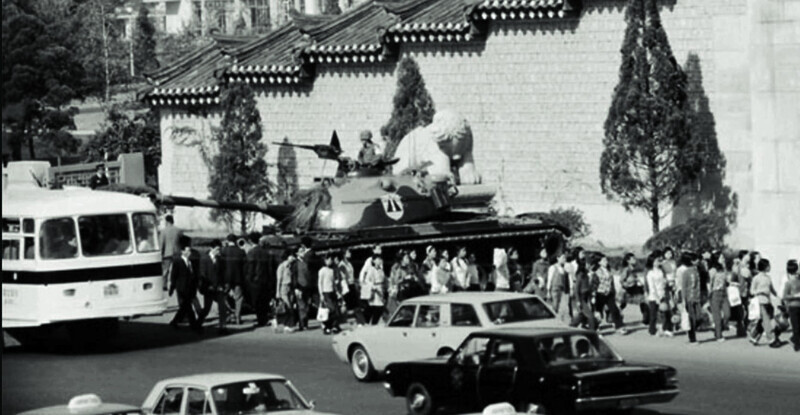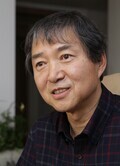hankyoreh
Links to other country sites 다른 나라 사이트 링크
[Column] Tanks and BTS fans in front of Gwanghwamun

A tank was parked in front of the gate of Gwanghwamun of Gyeongbok Palace in Seoul. Its long barrel and machine guns were pointed at the nearby square. Along the wall surrounding the palace, soldiers were toting guns with fixed bayonets. This was the scene that greeted me on the first day of the October Restoration, the military coup in which Park Chung-hee made his “special presidential declaration,” pronouncing himself president and assuming dictatorial powers.
It was a sunny fall morning on Oct. 17, 1972, as I headed to school as a student in my second year of high school. During our first break, I asked my friends, “Did you see the tank in front of Gwanghwamun? Isn’t it cool?” One of my friends reproachfully replied, “Democracy is dead. What’s cool about that?” I suddenly felt abashed.
In my next class, I could no longer pay attention to what the teacher was talking about. In my head, the words “democracy is dead” kept repeating themselves. What had happened? They said it was a “restoration” for the sake of reunification with North Korea. There had been inter-Korean talks for some time, and hopes for reunification were growing. Yet the idea of “dictatorship for reunification” seemed far-fetched.
At lunch, I began talking to my friends again. They said all university classes had been suspended, and that they thought it was a good idea for us to make our voices heard even as high school students. We numbered seven in all, meeting up during every break time. We printed up messages opposing the Yushin Constitution and distributed them around our school. A few days later, I was arrested and taken to the Jongno Police Station holding cell, then to the Capital Garrison Command military police and finally to the Seodaemun Detention Center. Amid the chill winds of the “restoration,” Seodaemun was cold, dark, and frightening. This was the swift end to my naïve youth.
The South Korean Yushin Constitution and North Korea’s Socialist Constitution were proclaimed on the same day: Dec. 27, 1972. In this way, the president of the South’s Yushin regime and the leader of the North’s “only regime” formed a parallel. Each claimed that a dictatorial regime was made necessary by the other. With each leader holding power for life, many of those in his circle named his son/daughter as a future leader in the hopes of continuing to enjoy privileges.
Hereditary power and filial piety shown to leaders in both KoreasThis was how the hereditary transfer of power to Kim Jong-il and Kim Jong-un emerged in North Korea. As the system for Kim Jong-il’s succession entered full swing in the 1970s, numerous books and popular songs were banned in North Korea, with the intensifying censorship extending to areas of life including wardrobe and haircuts. Sound familiar? In the “liberal democracy” of South Korea, these were the same dictatorial controls that we lived through in the Yushin era.
There was also a “politics of symbolism” that involved the manufacturing of images. Both the “Korean-style socialism” of North Korea and the “Korean democracy” of South Korea emphasized the notion of filial piety. In the North, Kim Il-sung’s wife Kim Jong-suk was revered as the “mother of Choson”; in the South, Park Chung-hee’s wife Yuk Young-soo was the “benevolent national mother.” After Yuk’s death, 22-year-old Park Geun-hye took over her mother’s role as South Korea’s first lady, a position of key symbolism that placed her second in the protocol hierarchy.
During national athletic meets as part of the Saemaul Movement — a national campaign to modernize rural South Korea that also stressed filial piety — principals would perform 90-degree bows to the president’s “esteemed daughter” and prostrate themselves before her grandmothers. In both South and North Korea, the power elites have passed down privileges amid their hostile coexistence.
Koreans have spent decades trying to bring democracy to the countryThe crucial turning point came with South Korea’s democratization. Amid unrelenting resistance to the dictatorial regime by South Korean civil society, a transfer of power was institutionalized in the late 1980s. While Park Geun-hye was elected president in 2012 amid election interference by power institutions, she ended up being impeached by the candlelight revolution after her actions in handing out prerogatives and abusing her authority. In the process, South Korea broke the chain of the hereditary transfer of political power.
On another sunny fall afternoon in October 2020, I watched the changing of the guard ceremony in front of Gwanghwamun. Around me, young foreigners applauded each movement by the soldiers, who were dressed in traditional military garb with colorful flags. Explaining that they had come after seeing a BTS music video set at Gyeongbok Palace, they told me it was “really cool.” I thought of my younger self, the one who saw a tank in the very same location a half-century earlier and said it was “cool.”
In retrospect, those changes that happened over the years did not come all at once. Would we have been able to see BTS’ singing and dancing if the “prior album review system” were still around? Blacklisted filmmakers would never have been able to make movies like “Parasite”; the miniseries “Crash Landing on You” would have been punished as an artistic product “benefiting the enemy.” Democracy is not an event, but a process. It does not refer solely to changes in political regimes. It is an intense process of change, of awakening bodies and minds that have been tamed by the powers that be. All of those changes are things that we achieved together.
But it is not over. The National Security Act is very much alive and well, and if we were to see the return of authorities who try to apply it to the letter, we could find ourselves once again headed to the prosecutors’ offices and detention centers. I hope to see people endlessly standing before Gwanghwamun as the cold winds start to blow, posing their innocent queries to naked emperors. I can remember the wave of signs held by young students holding candles in Gwanghwamun Square. This is how South Korean democracy must be realized: by innocent minds revived across generations.

By Jung Byung-ho, professor emeritus of cultural anthropology at Hanyang University
Please direct comments or questions to [english@hani.co.kr]

Editorial・opinion
![[Editorial] Penalties for airing allegations against Korea’s first lady endanger free press [Editorial] Penalties for airing allegations against Korea’s first lady endanger free press](https://flexible.img.hani.co.kr/flexible/normal/500/300/imgdb/original/2024/0502/1817146398095106.jpg) [Editorial] Penalties for airing allegations against Korea’s first lady endanger free press
[Editorial] Penalties for airing allegations against Korea’s first lady endanger free press![[Editorial] Yoon must halt procurement of SM-3 interceptor missiles [Editorial] Yoon must halt procurement of SM-3 interceptor missiles](https://flexible.img.hani.co.kr/flexible/normal/500/300/imgdb/child/2024/0501/17145495551605_1717145495195344.jpg) [Editorial] Yoon must halt procurement of SM-3 interceptor missiles
[Editorial] Yoon must halt procurement of SM-3 interceptor missiles- [Guest essay] Maybe Korea’s rapid population decline is an opportunity, not a crisis
- [Column] Can Yoon steer diplomacy with Russia, China back on track?
- [Column] Season 2 of special prosecutor probe may be coming to Korea soon
- [Column] Park Geun-hye déjà vu in Yoon Suk-yeol
- [Editorial] New weight of N. Korea’s nuclear threats makes dialogue all the more urgent
- [Guest essay] The real reason Korea’s new right wants to dub Rhee a founding father
- [Column] ‘Choson’: Is it time we start referring to N. Korea in its own terms?
- [Editorial] Japan’s rewriting of history with Korea has gone too far
Most viewed articles
- 1[Editorial] Penalties for airing allegations against Korea’s first lady endanger free press
- 2Months and months of overdue wages are pushing migrant workers in Korea into debt
- 360% of young Koreans see no need to have kids after marriage
- 4In rejecting statute of limitations defense in massacre case, Korean court faces up to Vietnam War a
- 5Historic court ruling recognizes Korean state culpability for massacre in Vietnam
- 6“Those souls can rest now”: Vietnam massacre survivor reacts to Korean court win
- 7Bills for Itaewon crush inquiry, special counsel probe into Marine’s death pass National Assembly
- 8[Reporter’s notebook] In Min’s world, she’s the artist — and NewJeans is her art
- 9[Editorial] Verdict on Korea’s massacre in Vietnam a first step in atonement
- 101 in 3 S. Korean security experts support nuclear armament, CSIS finds